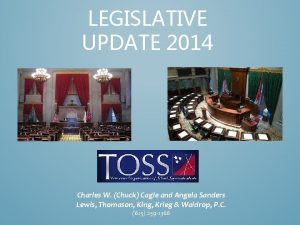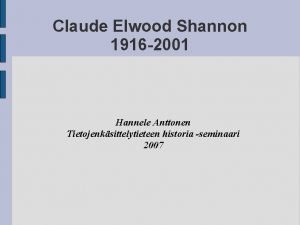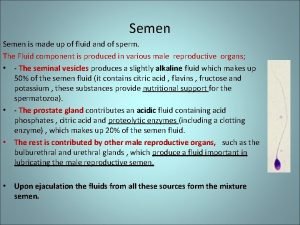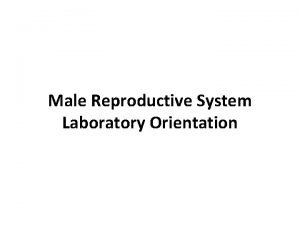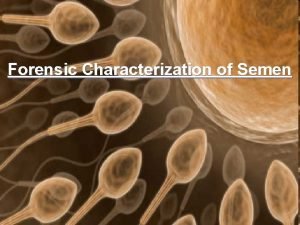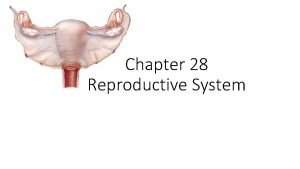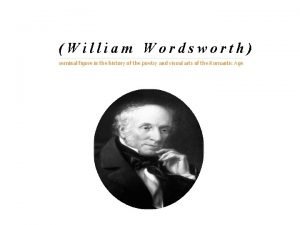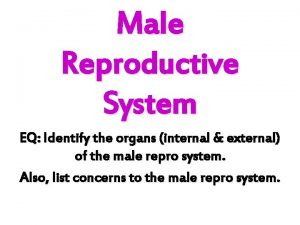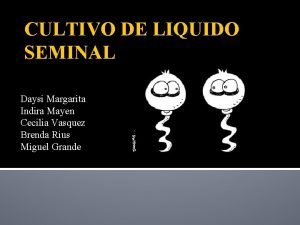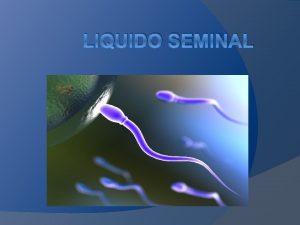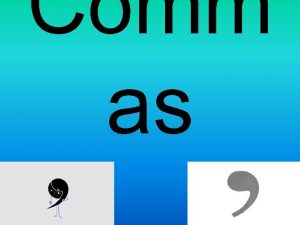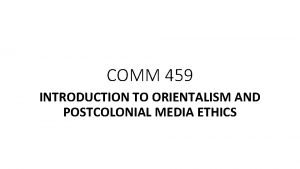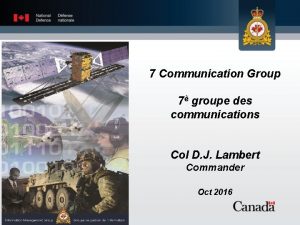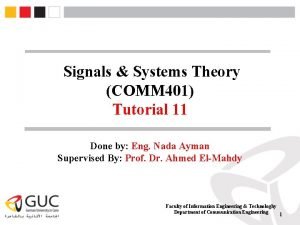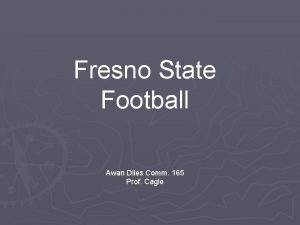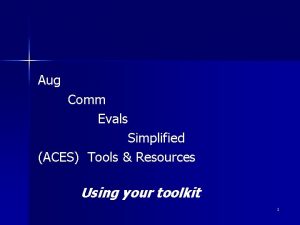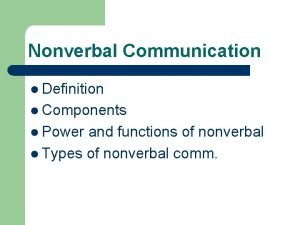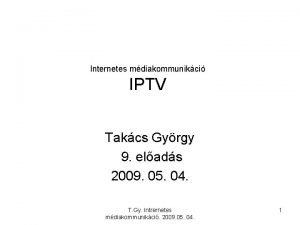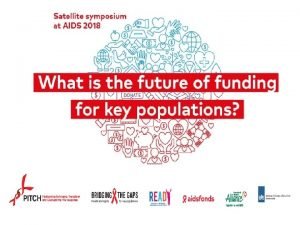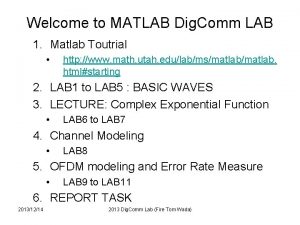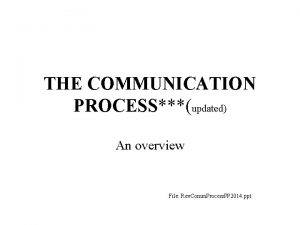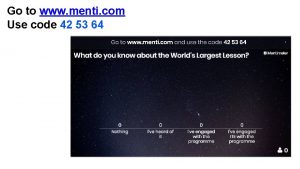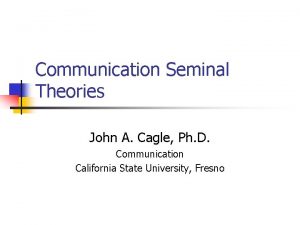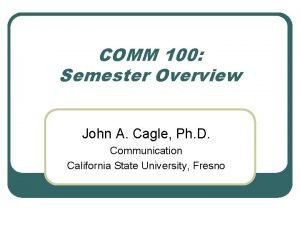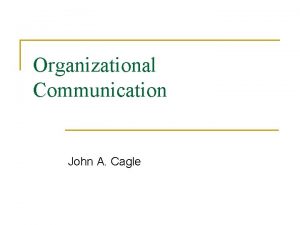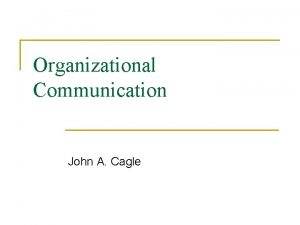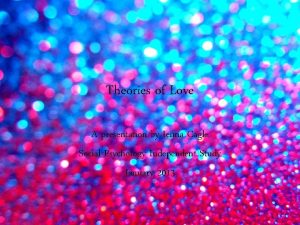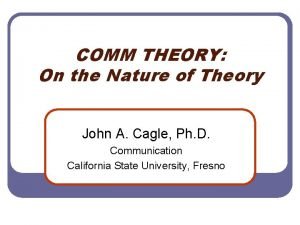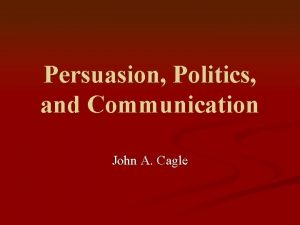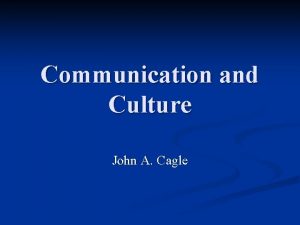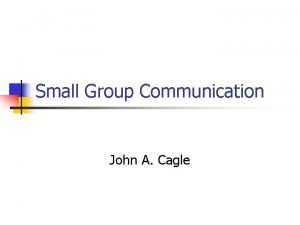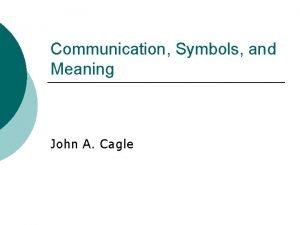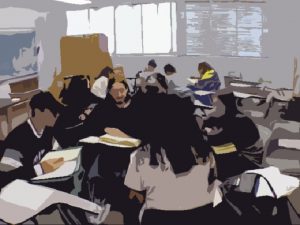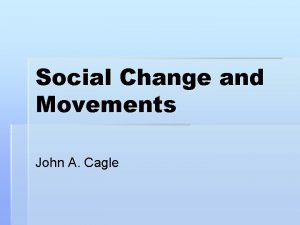COMM THEORY On Seminal Theories John A Cagle













































- Slides: 45

COMM THEORY: On Seminal Theories John A. Cagle, Ph. D. Communication California State University, Fresno

Harold D. Lasswell (1948) Who Says What in Which Channel to Whom with What Effect?

Franklin Fearing (1953) Communication behavior is a specific form of molar behavior which occurs in a situation or field possessing specified properties, the parts of which are in interdependent relationship with each other. A theory of such behavior is concerned with forces, psychological, social, and physical, which determine the course of this behavior and its outcomes in relation to the culture in which it occurs.

Such a theory should formulate hypothetical constructs and present a terminology with appropriate definitions in the following four interrelated areas: (a) the forces which determine the effects of communication, that is, constructs regarding individuals designated interpreters; (b) the forces which determine the production of communications, that is, constructs about communicators; (c) the nature of communications content considered as a stimulus field; (d) the characteristics of the situation or field in which communication occurs.

Information Theory Claude Shannon

Shannon & Weaver (1947) Norbert Weiner’s Cybernetics added the notion of feedback to this communication model.

Information Theory l l In a perfect communication system, the sender and receiver have identical knowledge of the code. All possible messages are known in advance. The source makes a choice to send a message from the set of possible messages. The receiver needs to know what choice the sender made.



Information is not content l l l A message has information if it reduces the uncertainty about what choice the sender made. If the choice is already known to the receiver, the message is redundant. Information is not content in information theory.

Aoccdrnig to a rscheearch at Cmabrigde Uinervtisy, it deosn't mttaer in waht oredr the ltteers in a wrod are, the olny iprmoetnt tihng is that the frist and lsat ltteer be at the rghit pclae. The rset can be a total mses and you can sitll raed it wouthit porbelm. Tihs is bcuseae the huamn mnid deos not raed ervey lteter by istlef, but the wrod as a wlohe. Amzanig huh?

Information is not meaning l l l Information is different from the content and meaning of messages. Information is not the interpretation of information. Peter Drucker wrote of the difference between informating and communicating in an organization.

Entropy l l Entropy is randomness, chaos, the lack of organization and predictability. Entropy is uncertainty. Information reduces entropy in a communication system. Entropy is variable in most situations.

Measurement of Information l l The smallest unit of information is a bit Eight bits = one byte Four bytes = one word These terms are still at the core of computer science • E. g. , 32 -bit word processors in the CPU

Measurement of Information l I = - log 2 pi is the formula for measuring the information value of each message sent against the probability of that message in the field of all the messages that could be sent.

Measurement of Information l H = - ∑ pi log 2 pi is the formula for measuring the amount of information of all the messages that could be sent in a communication system.

Choices l l Signal: we make choices about which signal to send (sounds, letters, etc. ) Semantics: we make choices in a given situation about which meaning to send. • • l Lexical choice Meaning Pragmatics: we make choices in a given situation about which behaviors to enact.

Communication behavior is a specific form of molar behavior _____1_____ occurs in a situation or field possessing specified properties, ____2_____ parts of which are in interdependent relationship with each _____3_____. A theory of such behavior is concerned with forces, _____4_____, social, and physical, which determine the course of this _____5_____ and its outcomes in relation to the culture in _____6_____ it occurs.

Samuel Becker (1968) We construct messages which "are, in effect, overlayed to form the large and complex communication environment or 'mosaic' in which each of us exists. This mosaic consists of an immense number of fragments or bits of information on an immense number of topics. . These bits are scattered over time and space and modes of communication. Each individual must grasp from this mosaic those bits which serve his needs, must group them into message sets which are relevant for him at any given time, and within each message set must organize the bits and close the gaps between them in order to arrive at a coherent picture of the world to which he can respond. "


Leah Vande Berg on Becker (1999) One of the most visionary aspects of Becker’s essay was his call for communication scholars to reconceptualize how we think of messages. . Becker’s call for messageaudience centered critical studies of differences among audience members moved far beyond the “active audience” notion. . In fact, Becker’s mosaic model of the fragmented processes entailed in receiving information and creating meanings, and his assertion that critical scholars should concentrate on differences among segments of audiences, prefigured the subsequent development of audience-centered critical media studies.

Information theory analysis choices freq rel freq I one 10 0. 33 1. 584963 -0. 53 two 6 0. 20 2. 321928 -0. 46 three 3 0. 10 3. 321928 -0. 33 four 3 0. 10 3. 321928 -0. 33 five 1 0. 03 4. 906891 -0. 16 six 1 0. 03 4. 906891 -0. 16 seven 1 0. 03 4. 906891 -0. 16 eight 1 0. 03 4. 906891 -0. 16 nine 1 0. 03 4. 906891 -0. 16 ten 1 0. 03 4. 906891 -0. 16 eleven 1 0. 03 4. 906891 -0. 16 twelve 1 0. 03 4. 906891 -0. 16 30 1. 00 H= 2. 97

Ring a-round the roses, A pocket full of posies, _____1_____! Ashes! We all fall down! Three blind mice, See how they run! They all _____2_____ after a farmer's wife, Who cut off their tails _____3_____ a carving knife. Did you ever see such a ____4______ in your life, As three blind mice?

Brian está en el aeropuerto de Barajas en Madrid. _____1_____ y otros estudiantes del grupo esperan la llegada del _____2_____ para ir a Leób. Deben esperar una hora. ¿Qué ____3______ hacer? 1 Alice 2 vuelo 3 deciden

Fritz Heider (1946) Balance Theory People try to maintain a certain type of consistency between their opinions of other people and their opinions of what those other people say. Imbalance produces a psychological stress that must be resolved.



Theodore Newcomb (1953) Communication among humans performs the essential function of enabling two or more individuals to maintain simultaneous orientation toward one another as communicators and toward objects of communication. The term “orientation” is used as equivalent to “attitude” in its more inclusive sense of referring to both cathectic and cognitive tendencies.

X A B

Tuna Casserole “Crap—I hate tuna casserole. ” - “I have cooked a delicious casserole for our dinner. ” + “I love you, Eve” John + + “I love you, John” Eve

Westley & Mac. Lean (1957)


Watzlawick, Beavin, and Jackson (1967) Their theory is based on a systems paradigm. Their book, Pragmatics of Human Communication, posited five axioms of communication.

Watzlawick, Beavin, and Jackson (1967) Five Axioms of Communication l l l 1. One cannot communicate. 2. Every communication has a content and a relationship aspect such that the latter defines the former and is therefore metacommunication. 3. Every communication sequence is defined by the way the interactants punctuate communication events. 4. Interpersonal contacts are digital and analogic. 5. Communication relationships are either symmetrical or complementary.

Del Hymes (1966) 1. What are the communicative events, and their components, in a community? 2. What are the relationships among them? 3. What capabilities and states do they have, in general, and in particular events? 4. How do they work?

The concept of a message is taken as implying the sharing (real or imputed) of a code (or codes) in terms of which a message is intelligible to participants, minimally an addressor and addressee, in an event constituted by transmission of the message, and characterized by a channel, a setting or context, a definite form or shape in the message, and a topic or comment.

Jakobson’s Model of Communicative Functions (1960) Hymes builds upon Type Oriented Example Function towards emotive expressing addresser It’s bloody feelings or pissing down attitudes again! (cf. http: //www. aber. ac. uk/media/Functions/mcs. html) referential context imparting

Jakobson’s Model continued Type Function Example phatic Oriented towards contact establishing or maintaining Nasty weather again, isn’t it? social relationships metalingual code This is the referring to the (http: //www. aber. ac. uk/media/Functions/mcs. html) nature of the

Hymes adds contextual and metacommunicative functions to Jakobson

Frank E. X. Dance (1970) His study identified 15 distinct conceptual components in the various definitions. His analysis identified three points of "critical conceptual differentiation" which form the basic dimensions along which the various definitions differ: (1) Level of observation. E. g. , restricted as in a definition pertaining to radio communication, very broad as in Stevens's definition of communication as a discriminatory response of a organism to a stimulus. (2) Intentionality. (3) Normative judgment. Implicit judgment as to success or value of the behavior.

Conceptual Components of Communication l l l l Symbols/verbal/speech Understanding Interaction/relationship/ social process Reduction of uncertainty Process Transfer/transmission/ interchange Linking/bonding l l l l Commonality Channel/carrier/means/ route Replicating memories Discriminative response/ behavior-modifyingresponse Stimuli Intentional Time/situation Power


Bowers and Bradac Axioms (1984) A number of competing sets of axioms undergird contemporary communication research and theory. 1 a Communication is the transmission and reception of information. 1 b Communication is the generation of meaning. 2 a Communication is individual behavior. 2 b Communication is the relationship among behaviors of interacting individuals. 3 a Human communication is unique. 3 b Human communication is a form of animal communication.

4 a Communication is processual. 4 b Communication is static. 5 a Communication is contextualized. 5 b Communication is noncontextualized. 6 a Human beings cannot communicate. 6 b Human beings can not communicate. 7 a Communication is a ubiquitous and powerful force in society. 7 b Communication is one among many forces in society, and a relatively weak one.

Definitional Issues Intentionality: to what degree, if any, does intention play in communication? Symbolic behaviors: what behavior is symbolic? Rhetorical theory and communication theory
 Chuck cagle
Chuck cagle Tiedonsalaus
Tiedonsalaus Seamen definition sperm
Seamen definition sperm Male genitalia
Male genitalia Seminal stain
Seminal stain Seminal vesicle in earthworm location
Seminal vesicle in earthworm location Lumbricus dissection
Lumbricus dissection Similarities between female and male reproductive system
Similarities between female and male reproductive system Seminal figure meaning
Seminal figure meaning Note on male reproductive system
Note on male reproductive system Penis é um musculo
Penis é um musculo Fotos de órgãos femininos
Fotos de órgãos femininos Cultivo liquido seminal
Cultivo liquido seminal Seminal tubules
Seminal tubules Hyperplasia
Hyperplasia Male reproductive anatomy
Male reproductive anatomy Semen de que esta compuesto
Semen de que esta compuesto Pouch of douglas
Pouch of douglas Color gris opalescente
Color gris opalescente Proper comm
Proper comm Joinmyquiz
Joinmyquiz When to use a comm
When to use a comm Apa itu intrapersonal communication
Apa itu intrapersonal communication Intrapersonal comm
Intrapersonal comm Roborio comm light red
Roborio comm light red Comm 459
Comm 459 Defsoc
Defsoc Comm 401
Comm 401 Mobilecricinfo
Mobilecricinfo Comm 3 fresno state
Comm 3 fresno state Cato's letters big idea
Cato's letters big idea Rec net
Rec net Comm 486
Comm 486 Aug comm device
Aug comm device Www-menti-com
Www-menti-com Nonverbal communication definition
Nonverbal communication definition Net comm wireless
Net comm wireless Beeg comm
Beeg comm Www.mwnti .com
Www.mwnti .com Mit be comm lab
Mit be comm lab Rev.comm
Rev.comm Menti com
Menti com Https://www.menti.com
Https://www.menti.com Comm portal
Comm portal Www.menti.com 4812915
Www.menti.com 4812915 Wwwmenti
Wwwmenti
